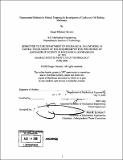| dc.contributor.advisor | Matt Lang. | en_US |
| dc.contributor.author | Navarro, Sergio Michael | en_US |
| dc.contributor.other | Massachusetts Institute of Technology. Dept. of Mechanical Engineering. | en_US |
| dc.date.accessioned | 2009-04-29T17:25:54Z | |
| dc.date.available | 2009-04-29T17:25:54Z | |
| dc.date.copyright | 2008 | en_US |
| dc.date.issued | 2008 | en_US |
| dc.identifier.uri | http://hdl.handle.net/1721.1/45324 | |
| dc.description | Thesis (S.B.)--Massachusetts Institute of Technology, Dept. of Mechanical Engineering, 2008. | en_US |
| dc.description | Includes bibliographical references (leaves 46-47). | en_US |
| dc.description.abstract | This thesis focuses on the design and implementation of a range of experimental methods by optical trapping in order to investigate the mechanical behavior of the leukocyte cell membrane as it undergoes cell rolling. Membrane tethers extracted from the cell during rolling function to slow the cell down and to maintain contact with the endothelial wall. Understanding the dynamic behavior of the leukocyte membrane during rolling motion sheds much insight on the relationship between stages of cell immunological response and the mechanical processes occurring on the surface of the cell membrane. Traditionally, the membrane response during rolling has been probed by simulating the tethering phenomenon in vitro. However, previous work has focused on pulling tethers at a constant velocity where as during in vivo rolling the tether extension will be a function of time. The fundamental differences between constant velocity and rolling-like leukocyte tethering as well as the role of the membrane-cytoskeleton interactions during tethering were specifically focused on in this study. Research work relied on the development of biomechanical optical trapping experiments occurring in an in-vitro setting in an attempt to elucidate an accurate mechanical model accurately describing behavior of the cell during rolling. Initial results indicate that the forces necessary to pull tethers from an immortalized B cell line ranged from 40 pN to 200 pN during linear dynamic behavior, yet ranged from 100 pN to 280 pN during rolling dynamic behavior. Furthermore, a liposome system mimicking functionality of the plasma membrane and lipid reservoir of the leukocyte cell membrane has been developed. Additional experiments are needed to verify preliminary results. | en_US |
| dc.description.statementofresponsibility | by Sergio Michael Navarro. | en_US |
| dc.format.extent | 52 leaves | en_US |
| dc.language.iso | eng | en_US |
| dc.publisher | Massachusetts Institute of Technology | en_US |
| dc.rights | M.I.T. theses are protected by
copyright. They may be viewed from this source for any purpose, but
reproduction or distribution in any format is prohibited without written
permission. See provided URL for inquiries about permission. | en_US |
| dc.rights.uri | http://dspace.mit.edu/handle/1721.1/7582 | en_US |
| dc.subject | Mechanical Engineering. | en_US |
| dc.title | Experimental methods by optical trapping for investigation of leukocyte cell rolling mechanics | en_US |
| dc.type | Thesis | en_US |
| dc.description.degree | S.B. | en_US |
| dc.contributor.department | Massachusetts Institute of Technology. Department of Mechanical Engineering | |
| dc.identifier.oclc | 314407549 | en_US |
